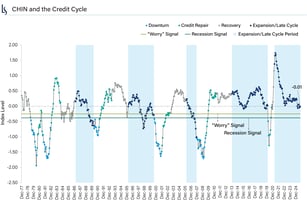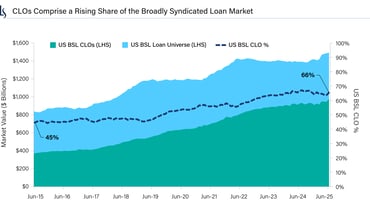
Investment Outlook
A potent combination of central bank easing and accelerating earnings growth is likely to propel global risk assets higher into 2026.
In our view, the initial jolt from significantly higher tariffs has already been largely reflected in the markets. Near term, we anticipate the tariffs will likely impede economic growth modestly.
Global central banks are attuned to the risk of overly restrictive policies, which opens the door to additional rate cuts and a possible economic acceleration into 2026. Inflation could be pressured higher as tariff price increases are passed through to consumers. However, we believe the Federal Reserve (Fed) will likely look past “one-time” price hikes that impact only certain imported goods.
There is potential for a significant rebound in global corporate profitability in 2026. US markets, like those measured by the S&P 500 Index, have shown fundamental leadership based on profitability in 2025. Bottom-up consensus earnings estimates for emerging markets, Europe and Japan imply year-on-year growth rates of 10% or higher for 2026. Given our pro-cyclical stance, it is encouraging to see global indices firmly in growth mode.
Investment Themes
Our take on macro drivers and major asset classes at a glance.

Macroeconomic Drivers
Near term, US inflation is likely to remain above the Fed’s objective of 2.0% growth in core personal consumption expenditures (PCE).

Corporate Credit
Credit market resilience looks likely to persist given strong fundamental expectations and minimal signs of excessive leverage across industries.

Government Debt & Policy
Central banks seek to ease policy rates toward neutral without disrupting the global economic expansion or reigniting inflation.

Currencies
Strong foreign currency performance may continue at a less robust pace than realized year to date.

Global Equities
We foresee a global bull market powered by high-growth artificial intelligence (AI) themes with help from interest-rate-sensitive areas of the market.

Potential Risks
The starting point for risk asset valuations is the most glaring risk investors face, in our view.
- Near term, US inflation is likely to remain above the Fed’s objective of 2.0% growth in core PCE.
- US corporates delivered strong earnings growth with consumers still spending in a somewhat elevated inflation regime.
- Higher-income consumers—who account for the bulk of spending—continue to benefit from the wealth effect (rising equity markets and home values).
- Lower-income consumers are under some financial pressure. That said, commentaries from the largest US financial institutions suggest credit and debit card spending trends are intact.
- The Quarterly Census of Employment and Wages reported a substantial downward revision to payrolls, which painted a weaker picture of the US labor market. Notably, companies continued to grow earnings with fewer new employees.
- Slipping labor force participation, paired with less hiring, can keep the unemployment rate stable.
- Outside the US, we believe a pick up in global growth, and a slightly weaker US dollar, would support global credit and equity markets.
Profit growth drives the credit cycle, and profits could boom during 2026.
Companies are unlikely to lay off employees while profits are growing. This should continue to support consumer borrowing and spending across economies.

Source: MSCI, Bloomberg, as of 23 September 2025.
Neither MSCI nor any other party involved in or related to compiling, computing or creating the MSCI data makes any express or implied warranties or representations with respect to such data (or the results to be obtained by the use thereof ), and all such parties hereby expressly disclaim all warranties of originality, accuracy, completeness, merchantability or fitness for a particular purpose with respect to any of such data. Without limiting any of the foregoing, in no event shall MSCI, any of its affiliates or any third party involved in or related to compiling, computing or creating the data have any liability for any direct, indirect, special, punitive, consequential or any other damages (including lost profits) even if notified of the possibility of such damages. No further distribution or dissemination of the MSCI data is permitted without MSCI’s express written consent.
The chart presented above is shown for illustrative purposes only. Used with permission from Bloomberg. Some or all of the information on this chart may be dated, and, therefore, should not be the basis to purchase or sell any securities. The information is not intended to represent any actual portfolio. Information obtained from outside sources is believed to be correct, but Loomis Sayles cannot guarantee its accuracy. This material cannot be copied, reproduced or redistributed without authorization.
Past performance is no guarantee of future results.
Corporate Credit
Credit market resilience looks likely to persist given strong fundamental expectations and minimal signs of excessive leverage across industries.
- Based on bottom-up fundamental analysis, our Credit Research Team suggests 85% of Bloomberg US Aggregate Index industries are in the expansion phase of the credit cycle.
- We believe economically-sensitive sectors, like large banks, retailers and building materials are all within the expansion phase— a positive forward-looking cyclical indicator.
- From a broad perspective during the quarter, our Credit Research Team's forward-looking views on credit have improved. Credit trends, profit margins and free cash flow are on firmer footing.
- Future tariff impacts are highly uncertain and developing over time at varying speeds for different industries. Overall, the outlook for the influence of tariffs is less negative than it was in June 2025.
- The expected US high yield default rate, an output of Loomis Sayles’ risk premium framework, suggests a low 3.4% expected default rate for the 12 months ending August 2026.
- Credit risk premiums are slim. While corporate credits continue to offer carry relative to Treasurys, excess return from spread compression looks harder to capture.
Despite some alarmist headlines, corporate credit spreads are sending a bullish message.
Investor demand for corporate credit has been strong and we expect that to continue.

Source: Bloomberg, JP Morgan, as of 19 September 2025.
The chart presented above is shown for illustrative purposes only. Used with permission from Bloomberg. Some or all of the information on this chart may be dated, and, therefore, should not be the basis to purchase or sell any securities. The information is not intended to represent any actual portfolio. Information obtained from outside sources is believed to be correct, but Loomis Sayles cannot guarantee its accuracy. This material cannot be copied, reproduced or redistributed without authorization.
Indices are unmanaged. It is not possible to invest directly in an index.
Past performance is no guarantee of future results.
Government Debt & Policy
Central banks seek to ease policy rates toward neutral without disrupting the global economic expansion or reigniting inflation.
- Government debt burdens are large but manageable for most countries. Markets seem to understand fiscal policy risks, which should preclude long-term yields from spiking.
- Several developed market interest rates have been moving higher at the 10-year and 30-year points on respective yield curves year to date. Steeper curves typically coincide with economic expansion.
- Year over year, yields are lower across the US Treasury curve, even though it steepened.
- We foresee global yield curves retaining their steepness, and see potential for further steepening through 2026.
- We think the Fed will likely deliver two more 25-basis-point rate cuts (late October and early December 2025). We anticipate one more cut in March 2026, before another pause to examine rate proximity to the neutral rate.
- The European Central Bank has seemingly reached a near-neutral policy rate. Relative to the Fed, the Bank of England is closer to its neutral rate. However, it’s likely to make further cuts by summer 2026.
- We prefer emerging market local-currency and sovereign bonds are preferred over developed market duration. Several countries have yield advantages relative to US Treasurys.
The Fed could cut twice more in 2025, while Japan and European central banks appear on hold.
The Bank of Japan may hike again by mid-2026, counter to its peers.

Source: Bloomberg, as of 24 September 2025.
The chart presented above is shown for illustrative purposes only. Used with permission from Bloomberg. Some or all of the information on this chart may be dated, and, therefore, should not be the basis to purchase or sell any securities. The information is not intended to represent any actual portfolio. Information obtained from outside sources is believed to be correct, but Loomis Sayles cannot guarantee its accuracy. This material cannot be copied, reproduced or redistributed without authorization.
Currencies
Strong foreign currency performance may continue at a less robust pace than realized year to date.
- In this global risk-on environment, we think diversifying portfolios and holding non-dollar exposure is a worthwhile strategy.
- Globally, the probability of recession has been decreasing for several months. We believe rightfully so. A “flight-to-safety” bid is no longer buoying the US dollar.
- The US administration’s willingness to negotiate trade deals with the US’s largest trading partners introduces upside risk to our already favorable view of non-dollar assets.
- In Europe—particularly in Germany—the shift toward more expansionary fiscal policies should raise its long-term-trend growth rates. The euro/US dollar exchange rate likely has upside over the long run.
- A stable-to-improving global growth backdrop should attract US-dollar-based investor capital. This trend could last for several quarters or longer in developed and emerging markets.
- We recommend non-dollar exposure via local-currency fixed income. Our preferred markets include Brazil, South Africa, Euro governments, Sweden, Norway and Mexico.
The broad dollar indices should continue to trend lower as the Fed cuts rates.
Dollar indices could break to new 52-week lows as we head into 2026.

Source: Bloomberg, as of 24 September 2025.
The chart presented above is shown for illustrative purposes only. Used with permission from Bloomberg. Some or all of the information on this chart may be dated, and, therefore, should not be the basis to purchase or sell any securities. The information is not intended to represent any actual portfolio. Information obtained from outside sources is believed to be correct, but Loomis Sayles cannot guarantee its accuracy. This material cannot be copied, reproduced or redistributed without authorization.
Indices are unmanaged. It is not possible to invest directly in an index.
Past performance is no guarantee of future results.
Global Equities
We foresee a global bull market powered by high-growth artificial intelligence (AI) themes with help from interest-rate-sensitive areas of the market.
- We believe the Russell 2000 Index is likely to join other global indices at new 52-week highs in the months ahead as profitability within the index finally broadens out.
- AI-driven capital expenditure is a lasting theme that should help propel equity markets and domestic investments for years to come.
- We see opportunities outside of large-cap tech and the AI theme. Despite lower relative fundamentals, the Russell 2000 Index has been outperforming the capitalization-weighted S&P 500 Index since the April 2025 lows.
- The financial sector is also rallying and showing very steady uptrends across small-through-large cap indices. A healthy financial sector is a positive indicator for the credit cycle’s direction.
- We believe the global bull market has staying power. Of the global equity indices we monitor, 80% are within 2% of their 52-week or all-time high levels.i
- We are optimistic about global equity markets. We believe strong performance can be delivered even if robust earnings estimates prove a little too optimistic.
Global equities are in an uptrend across the board with the bulk of indices above respective 200-day and 50-day moving averages.
The Dow Jones Transportation Average underperformance is notable but not disastrous. The US economy is more closely linked to technology than shipping and hauling.

Source: Bloomberg, as of 23 September 2025.
The chart presented above is shown for illustrative purposes only. Used with permission from Bloomberg. Some or all of the information on this chart may be dated, and, therefore, should not be the basis to purchase or sell any securities. The information is not intended to represent any actual portfolio. Information obtained from outside sources is believed to be correct, but Loomis Sayles cannot guarantee its accuracy. This material cannot be copied, reproduced or redistributed without authorization.
Indices are unmanaged. It is not possible to invest directly in an index.
Past performance is no guarantee of future results.
Potential Risks
The starting point for risk asset valuations is the most glaring risk investors face, in our view. Credit spreads are near multi-year tight levels. US equity price-to-earnings multiples are a few turns above their five-year averages. Forward-looking total return prospects are positive, but not overwhelmingly so. We believe market corrections could provide opportunity as long as the fundamental backdrop is not disrupted.
- The Loomis Sayles Macro Strategies Team is projecting a near-20% probability of a US recession. The estimate is far from the team's base case, but not trivial.
- US payroll growth proved much less robust than projected earlier this year. The current economic expansion and market rally hinges on a stable labor market and consumer spending.
- Risk premiums are slim across US credit and equity markets, which leaves them vulnerable to exogenous shocks and earnings disappointments, in our view.
- An unexpected inflation surge could disrupt markets and put central bankers in a difficult position. Markets would likely suffer a deep correction in that event and fundamentals could also deteriorate.
- Geopolitical risk is present but not driving markets. Spiking crude oil prices on the back of growing geopolitical risk would hit consumer wallets.
Asset Class Outlook
Our outlook for most markets is bright and backed by solid fundamental expectations.

Author
Craig Burelle
Global Macro Strategist, Credit
Endnote
i Source: Bloomberg, as of 23 September 2025.
Disclosure
This marketing communication is provided for informational purposes only and should not be construed as investment advice. Any opinions or forecasts contained herein reflect the subjective judgments and assumptions of the authors only and do not necessarily reflect the views of Loomis, Sayles & Company, L.P. Investment recommendations may be inconsistent with these opinions. There is no assurance that developments will transpire as forecasted and actual results will be different. Data and analysis do not represent the actual or expected future performance of any investment product. Information, including that obtained from outside sources, is believed to be correct, but Loomis Sayles cannot guarantee its accuracy. This information is subject to change at any time without notice. Intended for institutional investors and investment professional use only.
Diversification does not ensure a profit or guarantee against a loss.
Market conditions are extremely fluid and change frequently.
Commodity, interest and derivative trading involves substantial risk of loss.
Indices are unmanaged and do not incur fees. It is not possible to invest directly in an index.
Any investment that has the possibility for profits also has the possibility of losses, including the loss of principal.
Past performance is no guarantee of future results.
LS Loomis | Sayles is a trademark of Loomis, Sayles & Company, L.P. registered in the US Patent and Trademark Office.
8477222.1.1


